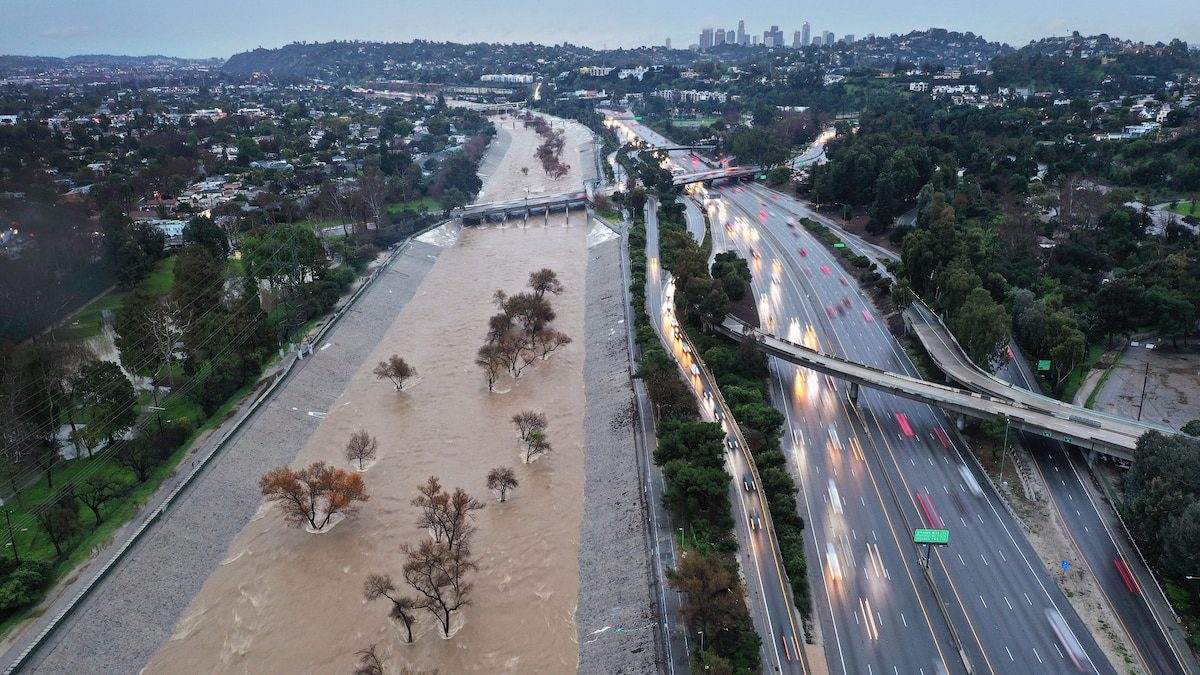Climate change is upping the odds that a disastrous flood with up to 10 feet of water might actually happen in California. The ARkStorm may not be real yet, but it’s scientifically plausible.
Published February 8, 2024
If it happens, it will be relentless—sheets of rain streaming down on California over the course of weeks, totaling up to 10 feet of water in some areas. Rivers, levees, gutters, and other systems designed to capture and drain precipitation will fill, then overflow, inundating the surrounding communities. Mud and debris will slide down steep hillsides, potentially dragging along cars and buildings. The flooding will be widespread and life-threatening, causing an estimated $1 trillion in economic losses.
This is the ARkStorm, a hypothetical but “scientifically plausible” storm scenario for California.
Experts from the United States Geological Survey, the National Oceanic and Atmospheric Administration, the Federal Emergency Management Agency, and a number of universities and state agencies developed this model storm based on data from historical storms in the 1800 and 1900s. While it’s been more than a decade since these researchers released their findings, the idea of an ARkStorm has become social media clickbait, with rumors around it circulating so broadly in late January that the California Office of Emergency Services released a video debunking predictions that such a storm was posing an imminent threat.
The first week of February did see historic storms and record rainfall in the state, totalling more than a foot of rain in certain regions. Nine people were killed, and numerous homes were destroyed or damaged due to flooding and landslides. But this pales in comparison to an ARkStorm-level event, according to Jeffrey Mount, senior fellow at the Public Policy Institute of California Water Policy Center, and it can be used as a warning of the potential for greater damage in the areas impacted.
“In Southern California, you got a fire hose,” Mount says. “We got a little glimpse of the kinds of things that can happen.”
What will the ARkStorm look like?
The name ARkStorm stands for “atmospheric river 1,000,” referring to the meteorological phenomena that would cause such intense rainfall and the probability of it happening in any given year. Atmospheric rivers, which are bands of water vapor carried to coasts by fast-moving winds, are not unfamiliar to Californians. NOAA says 30-50 percent of precipitation on the West Coast actually comes from atmospheric rivers, and the storms that hit California earlier this month were examples of these events.
(Learn more about atmospheric rivers.)
What would make an ARkStorm-like event unique is the widespread nature of the atmospheric river, which would stretch across much of California, as well as its multi-week stall over the state and hurricane-force winds. There are specific examples in the past of this type of behavior, including storms in 1861 and 1862 that resulted in 45 days of rain. But climate change is also altering the calculus of what future storms might hold.
In 2022, Xingying Huang from the National Center for Atmospheric Research and Daniel Swain from the University of California, Los Angeles revisited the scenario, using advances in atmospheric modeling to further assess how the ARkStorm might play out given warming conditions.
The ARkStorm 2.0, as they called it, found that the odds of “an event capable of producing catastrophic flooding” have doubled due to climate change.
When will it happen?
The USGS describes the ARkStorm as “perhaps inevitable,” but there’s no way of predicting exactly when it will be until the storm starts appearing on the radar.
“It could happen this year, it could happen next year, it might not happen for 50 or 60 years,” Swain said in a recent YouTube livestream. There’s no cyclical nature to these storms, so we don’t necessarily expect them to occur at any time, he explained. But when you look at the state’s history, they’ve happened about every couple hundred years.
That said, Swain noted that he’s seen social media theories about the ARkStorm’s arrival pretty much since the first paper was published in 2011 and encouraged people to pay attention to official channels for forecasts.
Is California prepared for a megaflood?
Part of the purpose of the ARkStorm modeling scenario was to address this question, and the short answer, according to the USGS, is no. The agency’s website puts it simply: “Californian flood protection is not designed for an ARkStorm-like event.”
Much of the state’s infrastructure is built to withstand rains based on average risks from historical events, so this would pose a significantly higher threshold, and that doesn’t even account for the additional challenges the high winds would pose.
But it’s not just a matter of needing to retrofit and build better systems—it’s also a challenge of awareness, Mount says. Many cities in California have allowed for extensive development in flood zones, and the areas hardest hit during disasters are often lower income communities that have been historically underfunded. According to his Center’s research, Mount says the vast majority of homeowners who are likely to be impacted do not have flood insurance.
“When the sun is shining,” Mount says, “people don’t want to think about floods, and they don’t want to pay for it because they’re paying for something that might happen in the future.”
